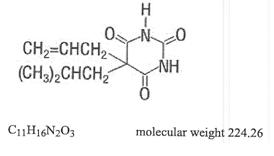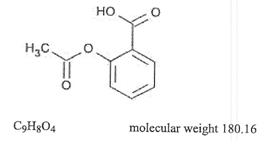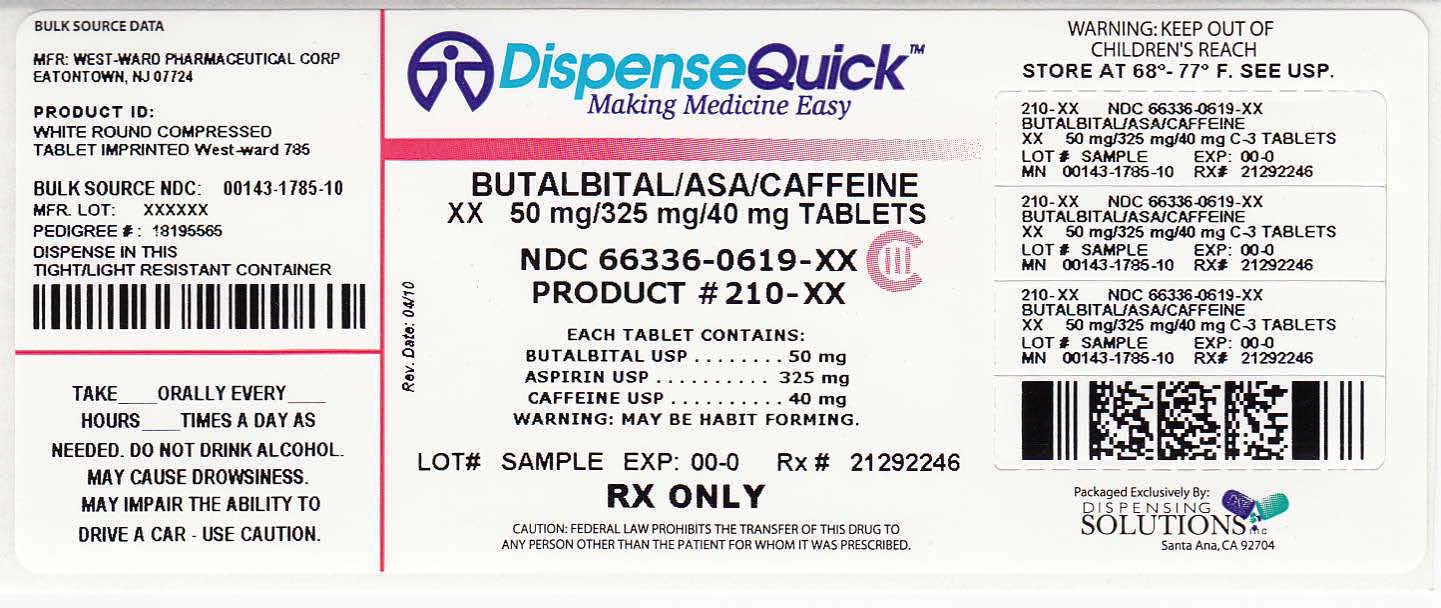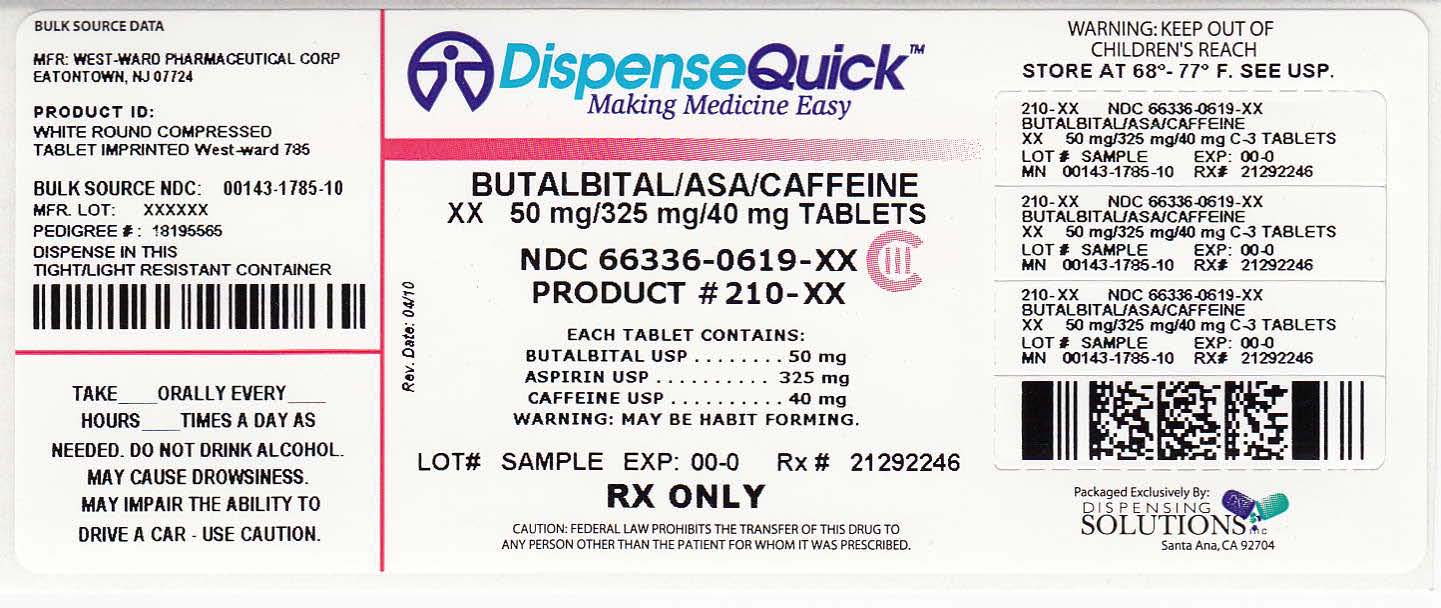Label: BUTALBITAL, ASPIRIN AND CAFFEINE tablet
-
Contains inactivated NDC Code(s)
NDC Code(s): 66336-619-30, 66336-619-60 - Packager: Dispensing Solutions, Inc.
- This is a repackaged label.
- Source NDC Code(s): 0143-1785
- Category: HUMAN PRESCRIPTION DRUG LABEL
Drug Label Information
Updated September 29, 2011
If you are a healthcare professional or from the pharmaceutical industry please visit this version.
- Download DRUG LABEL INFO: PDF XML
- Official Label (Printer Friendly)
- SPL UNCLASSIFIED SECTION
-
DESCRIPTION:
Each Butalbital, Aspirin, and Caffeine tablet for oral administration contains:
Butalbital, USP 50 mg
Aspirin, USP 325 mg
Caffeine, USP 40 mg
Butalbital, 5-allyl-5-isobutyl-barbituric acid, a white odorless crystalline powder; is a short-to intermediate-acting barbiturate. Its structural formula is as follows:

Aspirin, salicylic acid acetate, is a non-opiate analgesic, anti-inflammatory and antipyretic agent. It occurs as a white, crystalline tabular or needle-like powder and is odorless or has a faint odor. Its structural formula is as follows:

Caffeine, 1,3,7-trimethylxanthine, is a central nervous system stimulant which occurs as a white powder or white glistening needles. It also has a bitter taste. Its structural formula is as follows:

Inactive Ingredients: Hydrogenated Vegetable Oil, Microcrystalline Cellulose, Sodium Starch Glycolate, Starch 1500 and Talc.
-
CLINICAL PHARMACOLOGY
Pharmacologically, butalbital, aspirin, and caffeine combines the analgesic properties of aspirin with the anxiolytic and muscle relaxant properties of butalbital.
The clinical effectiveness of butalbital, aspirin, and caffeine in tension headache has been established in double-blind, placebo-controlled, multi-clinic trials. A factorial design study compared butalbital, aspirin, and caffeine with each of its major components. This study demonstrated that each component contributes to the efficacy of butalbital, aspirin, and caffeine in the treatment of the target symptoms of tension headache (headache pain, psychic tension, and muscle contraction in the head, neck, and shoulder region). For each symptom and the symptom complex as a whole, butalbital, aspirin, and caffeine was shown to have significantly superior clinical effects to either component alone.
Aspirin:
The systemic availability of aspirin after an oral dose is highly dependent on the dosage form, the presence of food, the gastric emptying time, gastric pH, antacids, buffering agents, and particle size. These factors affect not necessarily the extent of absorption of total salicylates but more the stability of aspirin prior to absorption.
During the absorption process and after absorption, aspirin mainly hydrolyzed to salicylic acid and distributed to all body tissues and fluids, including fetal tissues, breast milk, and the central nervous system (CNS). Highest concentrations are found in plasma, liver, renal cortex, heart, and lung. In plasma, about 50%-80% of the salicylic acid and its metabolites are loosely bound to plasma proteins.
The clearance of total salicylates is subject to saturable kinetics; however, first-order elimination kinetics are still a good approximation for doses up to 650 mg. The plasma half-life for aspirin is about 12 minutes and for salicylic acid and/or total salicylates is about 3.0 hours.
The elimination of therapeutic doses is through the kidneys either as salicylic acid or other biotransformation products. The renal clearance is greatly augmented by an alkaline urine as is produced by concurrent administration of sodium bicarbonate or potassium citrate.
The biotransformation of aspirin occurs primarily in the hepatocytes. The major metabolites are salicyluric acid (75%), the phenolic and acyl glucuronides of salicylate (15%), and gentisic and gentisuric acid (1%). The bioavailability of the aspirin component butalbital, aspirin, and caffeine is equivalent to that of a solution except for a slower rate of absorption. A peak concentration of 8.80 mcg/mL was obtained at 40 minutes after a 650 mg dose. (see OVERDOSAGE for toxicity information).
Butalbital:
Butalbital is well absorbed from the gastrointestinal tract and is expected to distribute to most of the tissues in the body. Barbiturates, in general, may appear in breast milk and readily cross the placental barrier. They are bound to plasma and tissue proteins to a varying degree and binding increases directly as a function of lipid solubility.
Elimination of butalbital is primarily via the kidney (59%-88% of the dose) as unchanged drug or metabolites. The plasma half-life is about 35 hours. Urinary excretion products included parent drug (about 3.6% of the dose), 5-isobutyl-5-(2,3-dihydroxypropyl) barbituric acid (about 24% of the dose), 5-allyl-5(3-hydroxy-2-methyl-1-propyl) barbituric acid (about 4.8% of the dose), products with the barbituric acid ring hydrolyzed with excretion of urea (about 14% of the dose), as well as unidentified materials. Of the material excreted in the urine, 32% was conjugated.
The bioavailability of the butalbital component of butalbital, aspirin, and caffeine is equivalent to that of a solution except for a decrease in the rate of absorption. A peak concentration of 2020 ng/mL is obtained at about 1.5 hours after a 100 mg dose.
The in vitro plasma protein binding of butalbital is 45% over the concentration range of 0.5 to 20 mcg/mL. This falls within the range of plasma protein binding (20% to 45%) reported with other barbiturates such as phenobarbital, pentobarbital, and secobarbital sodium. The plasma-to-blood concentration ratio was almost unity indicating that there is no preferential distribution of butalbital into either plasma or blood cells. (see OVERDOSAGE for toxicity information).
Caffeine:
Like most xanthines, caffeine is rapidly absorbed and distributed in all body tissues and fluids, including the CNS, fetal tissues, and breast milk.
Caffeine is cleared rapidly through metabolism and excretion in the urine. The plasma half-life is about 3.0 hours. Hepatic biotransformation prior to excretion results in about equal amounts of 1-methyl-xanthine and 1-methyluric acid. Of the 70% of the dose that has been recovered in the urine, only 3% was unchanged drug.
The bioavailability of the caffeine component for butalbital, aspirin, and caffeine is equivalent to that of a solution except for a slightly longer time to peak. A peak concentration of 1660 ng/mL was obtained in less than an hour for an 80 mg dose (see OVERDOSAGE for toxicity information).
-
INDICATIONS AND USAGE
Butalbital, aspirin, and caffeine tablets are indicated for the relief of the symptom complex of tension (or muscle contraction) headache.
Evidence supporting the efficacy and safety of butalbital, aspirin, and caffeine in the treatment of multiple recurrent headaches is unavailable. Caution in this regard is required because butalbital is habit-forming and potentially abusable.
- CONTRAINDICATIONS
-
WARNINGS
Drug Dependency:
Prolonged use of barbiturates can produce drug dependence, characterized by psychic dependence, and less frequently, physical dependence and tolerance. The abuse liability of butalbital, aspirin, and caffeine is similar to that of other barbiturate-containing drug combinations. Caution should be exercised when prescribing medication for patients with a known propensity for taking excessive quantities of drugs, which is not uncommon in patients with chronic tension headache.
Use in Ambulatory Patients:
Butalbital, aspirin, and caffeine may impair the mental and/or physical abilities required for the performance of potentially hazardous tasks, such as driving a car or operating machinery. The patient should be cautioned accordingly. Central Nervous System depressant effects of butalbital may be additive with those of other CNS depressants. Concurrent use with other sedative-hypnotics or alcohol should be avoided. When such combined therapy is necessary, the dose of one or more agents may need to be reduced.
Use in Pregnancy:
Adequate studies have not been performed in animals to determine whether this drug affects fertility in males or females, has teratogenic potential, or has other adverse effects on the fetus. While there are no well-controlled studies in pregnant women, over twenty years of marketing and clinical experience does not include any positive evidence of adverse effects on the fetus. Although there is no clearly defined risk, such experience cannot exclude the possibility of infrequent or subtle damage to the human fetus. Butalbital, aspirin, and caffeine should be used in pregnant women only when clearly needed.
- PRECAUTIONS
-
ADVERSE REACTIONS
The most frequent adverse reactions are drowsiness and dizziness. Less frequent adverse reactions are lightheadedness and gastrointestinal disturbances including nausea, vomiting, and flatulence. A single incidence of bone marrow suppression has been reported with the use of butalbital, aspirin, and caffeine. Several cases of dermatological reactions including toxic epidermal necrolysis and erythema multiforme have been reported.
-
OVERDOSAGE
The toxic effects of acute overdosage of butalbital, aspirin, and caffeine are attributable mainly to its barbiturate component, and, to a lesser extent, aspirin. Because toxic effects of caffeine occur in very high dosages only, the possibility of significant caffeine toxicity from butalbital, aspirin, and caffeine overdosage is unlikely. Symptoms attributable to acute barbiturate poisoning include drowsiness, confusion, and coma; respiratory depression; hypotension; shock. Symptoms attributable to acute aspirin poisoning include hyperpnea; acid-base disturbances with development of metabolic acidosis; vomiting and abdominal pain; tinnitus; hyperthermia; hypoprothrombinemia; restlessness; delirium; convulsions. Acute caffeine poisoning may cause insomnia, restlessness, tremor, and delirium; tachycardia and extrasystoles. Treatment consists primarily of management of barbiturate intoxication and the correction of the acid-base imbalance due to salicylism. Vomiting should be induced mechanically or with emetics in the conscious patient. Gastric lavage may be used if the pharyngeal and laryngeal reflexes are present and if less than 4 hours have elapsed since ingestion. A cuffed endotracheal tube should be inserted before gastric lavage of the unconscious patient and when necessary to provide assisted respiration. Diuresis, alkalinization of the urine, and correction of electrolyte disturbances should be accomplished through administration of intravenous fluids such as 1% sodium bicarbonate in 5% dextrose in water. Meticulous attention should be given to maintaining adequate pulmonary ventilation. Correction of hypotension may require the administration of levartherenol bitartrate or phenylephrine hydrochloride by intravenous infusion . In severe cases of intoxication, peritoneal dialysis, hemodialysis, or exchange transfusion may be lifesaving. Hypoprothrombinemia should be treated with Vitamin K, intravenously.
- DOSAGE AND ADMINISTRATION
-
HOW SUPPLIED:
Butalbital, Aspirin, and Caffeine Tablets, USP 50 mg/325 mg/40 mg are White, Round, Unscored Compressed Tablets Imprinted “West-ward 785”.
Bottles of 30 tablets
Bottles of 50 tablets
Bottles of 100 tablets
Bottles of 500 tablets
Bottles of 1000 tablets
Unit Dose Boxes of 100 tabletsStore at 20-25oC (68-77oF) [See USP Controlled Room Temperature]. Protect from light and moisture.
Dispense in a tight, light-resistant container as defined in the USP using a child-resistant closure.
Manufactured By:
West-ward Pharmaceutical Corp
Eatontown, NJ 07724Revised. January 2009
- PRINCIPAL DISPLAY PANEL
-
INGREDIENTS AND APPEARANCE
BUTALBITAL, ASPIRIN AND CAFFEINE
butalbital, aspirin and caffeine tabletProduct Information Product Type HUMAN PRESCRIPTION DRUG Item Code (Source) NDC:66336-619(NDC:0143-1785) Route of Administration ORAL DEA Schedule CIII Active Ingredient/Active Moiety Ingredient Name Basis of Strength Strength BUTALBITAL (UNII: KHS0AZ4JVK) (BUTALBITAL - UNII:KHS0AZ4JVK) BUTALBITAL 50 mg ASPIRIN (UNII: R16CO5Y76E) (ASPIRIN - UNII:R16CO5Y76E) ASPIRIN 325 mg CAFFEINE (UNII: 3G6A5W338E) (CAFFEINE - UNII:3G6A5W338E) CAFFEINE 40 mg Inactive Ingredients Ingredient Name Strength CELLULOSE, MICROCRYSTALLINE (UNII: OP1R32D61U) SODIUM STARCH GLYCOLATE TYPE A POTATO (UNII: 5856J3G2A2) TALC (UNII: 7SEV7J4R1U) HYDROGENATED COTTONSEED OIL (UNII: Z82Y2C65EA) STARCH, CORN (UNII: O8232NY3SJ) Product Characteristics Color white Score no score Shape ROUND Size 11mm Flavor Imprint Code Westward;785 Contains Packaging # Item Code Package Description Marketing Start Date Marketing End Date 1 NDC:66336-619-30 30 in 1 BOTTLE, PLASTIC 2 NDC:66336-619-60 60 in 1 BOTTLE, PLASTIC Marketing Information Marketing Category Application Number or Monograph Citation Marketing Start Date Marketing End Date ANDA ANDA086162 06/05/1979 Labeler - Dispensing Solutions, Inc. (066070785) Establishment Name Address ID/FEI Business Operations Dispensing Solutions, Inc. 066070785 relabel, repack


